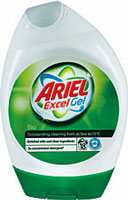 Ingredients
Ingredients- Aqua (water)
- Sodium laureth sulfate
- MEA dodecylbenzenesulfonate
- MEA palm kernelate
- MEA citrate
- C12-14 pareth-7
- PEI-ethoxylate
- Propylene glycol
- Glycosidase
- Protease
- Disodium distyrylbiphenyl disulfonate
- Trimonoethanolamine etidronate
- MEA borate
- Sodium sulfate
- Colorant
- Butylphenyl methylpropional
- Citronellol
- Eugenol
- Geraniol
- Linalool
Published April 2010
This detergent saves energy because, as it says, it "Washes clothes clean at 15 °C".
Ingredients
Surfactants are the negatively charged detergent molecules which do most of the cleaning. Surfactants have a water-seeking head attached to a grease-seeking tail and together they lift the dirt off clothes. Sodium laureth sulfate is a sustainable surfactant made from coconut oil. MEA dodecylbenzenesulfonate is an oil-based surfactant (MEA stands for methylethanolamine (H3CNHCH2CH2OH). MEA palm kernelate is a sustainable surfactant made from palm oil. The human body produces its own surfactants which it needs to keep the lungs working. It's these surfactants which explains why a man peeing into a toilet bowl sometimes produces a lot of lather.
Water softeners are needed to deactivate the calcium and magnesium ions of hard water. MEA citrate is a salt of citric acid. It is added to laundry detergents because it surrounds the calcium and magnesium ions so they cannot form insoluble scum with the surfactants or deposit on the washing machine as limescale. Although citric acid is present in citrus fruits like lemons, it is manufactured synthetically from sugar or starch by means of the fungus Aspergillus niger. Trimonoethanolamine etidronate is also good at keeping calcium and magnesium from interfering with the action of the detergents. Etidronates are also used in the treatment of osteoporosis, especially in woman after the menopause, and for other bone conditions.
Glycosidase and protease are the enzymes which digest food stains, as well as the unmentionable ones on underclothes. Glycosidase removes carbohydrates and protease removes proteins.
Disodium distyrylbiphenyl disulfonate acts as an optical brightener. It absorbs invisible UV light and re-emits it as white light so that white fabrics look whiter. This product is used in some cosmetics, and it is also supposed to reduce wrinkles.
PEI-ethoxylate - PEI stands for polyethylene imine - which consists of chains of carbon atoms interspersed with nitrogen atoms. It is soluble as its ethoxylate (aka acetate) derivative. It acts to prevents dirt and dye molecules that have been washed off fabrics from depositing themselves on other fabrics.
MEA borate is there to keep the pH of the gel slightly alkaline, and keep it so, thereby protecting the enzymes. MEA borate is also to be found in personal care products like Right Guard spray. Borate is also used as a wood preservative.
Propylene glycol (aka 1,2-propanediol) helps to keep all the diverse chemicals suspended in the gel. Propylene glycol is commonly used as an antifreeze.
C14-15 Pareth-7 consists of a chain of carbon atoms interspersed with oxygen atoms and its function is also to keep all the other ingredients suspended in the gel.
Fragrances
Butylphenyl methylpropional has a floral smell
Citronellol smells of roses
Eugenol smells of spices
Geraniol smells of roses
Linalool has a floral smell